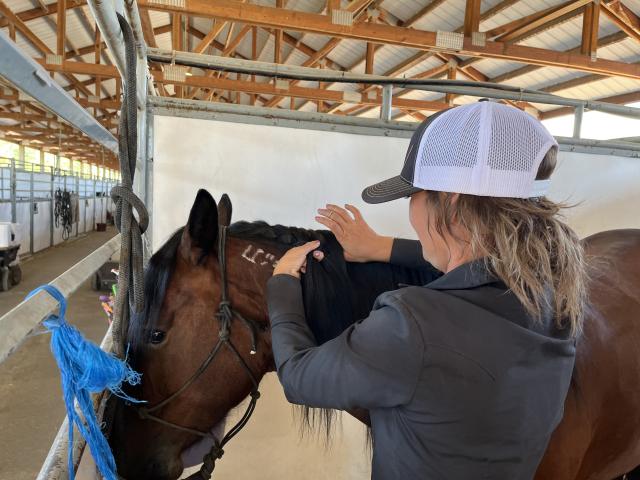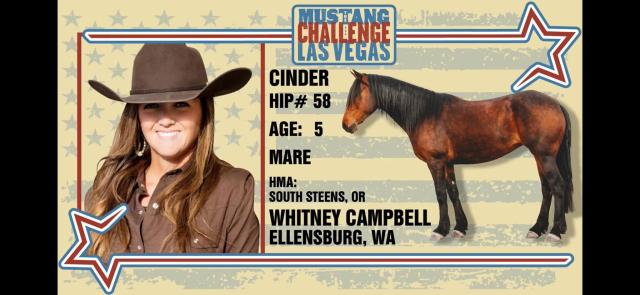You are viewing ARCHIVED content published online before January 20, 2025. Please note that this content is NOT UPDATED, and links may not work. Additionally, any previously issued diversity, equity, inclusion or gender-related guidance on this webpage should be considered rescinded. For current information, visit https://www.blm.gov/blog.
From the Open Range to the Las Vegas Lights Meet Cinder from South Steens
About 50 horses trotted into the spacious round corral, heads high, flicking their manes and snorting playfully at the humans standing on the viewing deck above them. The brisk November morning felt colder than it actually was, with the steady breeze punctuated by 35 mile per hour wind gusts. The horses were an assorted bunch; all mares in a variety of sizes, ages, and colors. There were colorful pintos along with bays, blacks, and browns, flanked by sorrels, buckskins, palominos, and a few duns.

The ball-cap clad cowgirl watching intently from the viewing area wasn’t really looking at the colors of the horses, though overall eye appeal definitely played a part in her discernment. Squinting through the dust, she watched for athleticism, fluidity of movement, and signs of a willing temperament that would readily adapt to a new environment. Out of the groups of horses admitted to the round pen, the cowgirl chose a handful of would-be candidates, which she eventually narrowed down to two finalists.
“I looked for a mare toward the middle of the pack,” explained Whitney Campbell, the trainer who had made the six and-and-a-half hour drive from her facility in Ellensburg, Washington to the Oregon Wild Horse Corral in Burns, Oregon. “I didn’t want one that just stood there and wouldn’t move her feet at all. I also wasn’t looking for a flighty, reactionary type that would lose her mind when I stepped into the pen with her.”
Campbell ultimately narrowed the field down to two bay five-year-old mares that, while similar in coloring, differed in conformation and temperament.
“The one mare looked really athletic. She was on the daintier side build-wise, and looked like she could be really catty, but she also seemed to be more reactionary in nature,” Campbell observed. “Cinder was the other candidate. I liked the way she paid attention to what was going on around her and seemed to think about what was happening before reacting. She seemed naturally balanced and changed leads easily going across the pen. I ultimately chose her because I felt she was the best candidate to demonstrate the beauty and adaptability of the American mustang.”
It wasn’t Campbell’s first time evaluating a pen of horses for trainability and athleticism. An accomplished horse trainer since her teen years, Campbell competed in her first Mustang Makeover in 2008 (“It was a train-wreck!” she laughed). She since became a preliminary competition winner and finalist at multiple mustang training competitions throughout the country.
So why, after working so hard to be among those at the pinnacle of their careers, was she standing on a windy platform in November choosing a mustang for the inaugural Mustang Challenge event?
Simple.
“Most everything I know about training horses started with me training mustangs. They teach you how to work with each unique animal to bring out its best qualities. They teach you finesse and timing and patience,” she observes. “Unlike a domestic horse raised to rely on humans, a wild horse retains survival instincts and sense of independence. He demands you be tactful and fair at all times. You absolutely cannot force him into anything.”
Campbell set about building a relationship with Cinder, who she laughingly called Cinder Block due to the mare’s early reluctance to move her feet once she was under saddle.
The first road trip on the docket? The NRCHA Stallion Stakes, one of the National Reined Cow Horse Association’s Premier Events, to be held in Las Vegas at the Southpoint Arena, coincidentally the same arena where the Mustang Challenge would take place.
She took Cinder to the Stakes, even though she’d only ridden her six times at that point. They were only walk-trot.
The first challenge was getting her there since Campbell hadn’t hauled her anywhere yet and was traveling alone. Campbell didn’t know what she was going to do if Cinder wouldn’t get back in the trailer after their overnight rest stop.
Fortunately, the innate trainability of the stocky bay proved itself, and she jumped right in the trailer the next morning. Now for the next hurdle: riding the barely-started mare in an arena filled with competitors practicing high speed maneuvers as they schooled their horses for the upcoming event.
“I decided I just had to go for it. She was pretty spooky at first and she sure stood out from the other horses with her shaggy winter coat, but she handled the chaos of the practice pen better than I had hoped,” Campbell chuckles.
Taking her to Vegas provided a great experience and ensured the horse didn’t sit in her pen without being ridden for a week. Of course it didn’t hurt that she would get to be in the same arena where they would compete in the Mustange Challenge.
“From then on I took her everywhere with me. With each new place and experience she just got better and better,” Campbell said.
Encouragement and advice from fellow trainers kept Campbell motivated and positive. Each of the tips she picked up helped get Cinder closer to where she wanted her to be for competition.

The program worked. After solid performances in the Mustang Challenge preliminary round—which consisted of ranch riding, trail, and reining classes—Campbell and Cinder made it to the Saturday clean slate finals, where the top eleven horses (10 plus a tie) out of the nearly 70 competitors would compete for a top prize of $50,000. Campbell was elated.
“I was a little worried after the trail class, when Cinder somehow managed to hit every lope pole in our pattern,” she laughed. “But as soon as I heard them call our names for the finals, I knew we were ready to bring our A-game to the party!”
The finals competition consisted of two parts. First, competitors would complete a series of judged compulsory maneuvers in the morning, and the score from that event would be combined with that from the Saturday evening Freestyle Competition to determine the Champion of the Mustang Challenge.
The duo’s performance in the morning finals event was not quite what Campbell was hoping for. Cinder felt a little tight and they blew their lead departure right off the bat. But the horse tried really hard through the rest of the pattern. Campbell knew they’d have to really nail their Freestyle to place near the top of the pack.
When the duo galloped into the arena dressed in costume and riding to a choreographed music combination of the movies Raiders of the Lost Ark and Star Wars, the crowd came to their feet. Cinder performed flawlessly, pulling a giant pretend stone from a mocked-up cave, loping fearlessly through obstacles and showcasing the amazing temperament that made Campbell choose her in the beginning. The roar of fan approval drowned out the ending notes of the team’s music, and it was soon apparent the people in the stands were not the only ones impressed.
At the awards presentation, Campbell and the bay mare were crowned Reserve Champion, receiving multiple prizes along with a check for $20,000.
Campbell and Cinder had little time to rest on their laurels; the team left early the next morning to get back to their Washington State home base. There, Campbell would continue to prepare client horses for upcoming cow horse shows.
When asked how she felt about taking time out from her busy schedule for future mustang competitions, Campbell’s response was immediate.
“You will definitely see me out there helping to showcase the versatility and trainability of these wonderful horses every chance I get,” she says. “In so many ways I owe everything to these animals, and I will do everything I can to help others recognize just how special they are.”
Thank you, Cinder and Whitney, for being such great ambassadors for America’s wild horses!
Audio Description video is also available: https://youtu.be/Ct4kNP0MiNY
Paula Cook, Idaho based author and BLM contributor
Related Stories
- Wild horses and burros find new homes at successful Wyoming adoption event
- Protecting Lands and Communities: Shaila Pomaikai Catan
- Strong turnout and new beginnings: 26 wild horses placed at Montana adoption event
- Celebrating the power of public lands through tourism and community impact
- BLM Wild Horse & Burro Program Adoption Experiences: Life After Adoption
